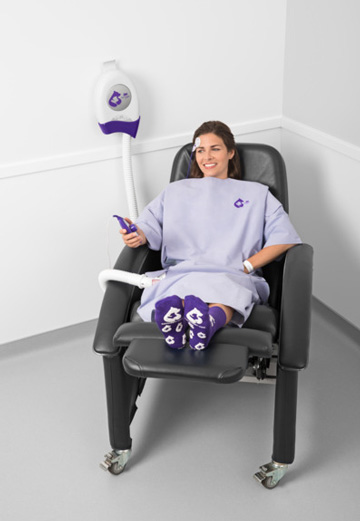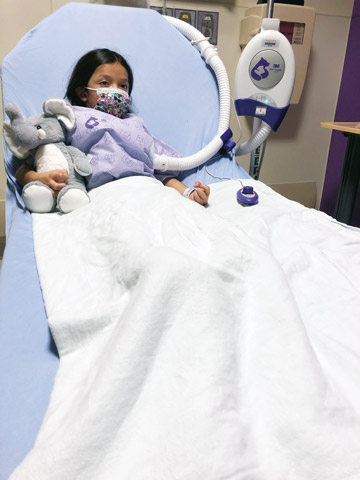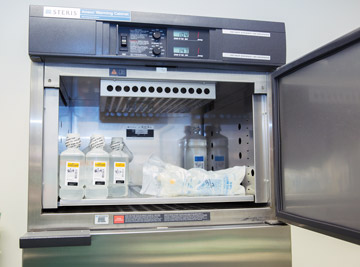The importance of improving patient outcomes with proactive temperature management to help avoid unintended hypothermia.
 CREDIT: 3M
CREDIT: 3M
Author Amanda Motter, RN, CNOR, is a registered nurse with operating room and preoperative experience in various specialties in pediatrics and adults. Amanda has worked as a specialty service leader and in OR leadership. In her current role at 3M in the Healthcare Business Group, she works with the perioperative and patient warming product portfolios on new product development and provides education, training, and support to global clinicians. She has spoken around the country on patient safety and infection control practices. She is a member of AORN and APIC.
 CREDIT: 3M
CREDIT: 3M
3M™ Bair Hugger™ Patient Warming System.
Maintaining normothermia, which is defined as core body temperature 36°C-37.5°C before, during and after surgery is critical.1,2 Keeping patients normothermic in all practice settings is critically important to help lower the risk of negative surgical outcomes associated with unintended hypothermia.
In fact, clinical practice guidelines, along with recommendations from the WHO and the CDC, recognize the critical nature of temperature management in ultimately helping to improve patient outcomes. Yet, perioperative hypothermia still remains a common, surgical complication that can lead to several adverse and sometimes deadly consequences.
The difference between a positive patient outcome and a complicated recovery can be simply a matter of degrees. Numerous studies have demonstrated that even mild hypothermia can result in significant complications, including increased rate of wound infection,3,4 increased mortality rates,5 coagulopathy,5-7 prolonged and altered drug effect,8 myocardial ischemia and cardiac disturbance,9,10 shivering and thermal discomfort,3,1-14 and delayed emergence from anesthesia.14
The major cause of intraoperative hypothermia is not heat loss to the environment or cold operating room temperature, but instead a phenomenon commonly referred to as redistribution temperature drop (RTD). RTD is caused by the action of anesthetic medications on the body's ability to properly thermoregulate. Under anesthesia, the ability of the hypothalamus to regulate temperature is diminished as the anesthetic agents reduce metabolism and depress the thermoregulatory response, triggering vasodilation – or an opening of the shunts used to retain warmer blood in the core.
Anesthetic-induced vasodilation allows heat in the warm core tissue to mix with cooler peripheral tissue, which warms the periphery at the expense of the core temperature.12,16 When warmer blood in the core mixes freely with cooler blood in the periphery, this causes a dramatic drop in core body temperature — up to 1.6°C within the first hour of surgery.15 This means that a patient who has a normal pre-induction core temperature of 36.2°C may be hypothermic approximately 7.5 minutes following induction.
Inadvertent perioperative hypothermia remains a common complication of surgery, however, a proactive approach to temperature management can help prevent it. The best solution is to institute such a proactive perioperative temperature management system to help maintain normothermia across the continuum of care.
Proactive temperature management
Proactive temperature management has three distinct goals: 1) increase preoperative mean body temperature (pre-op); 2) maintenance or restoration of intraoperative core body temperature (OR); and 3) post-operative thermal comfort and normothermia (PACU). For both ambulatory and hospital settings, Enhanced Recovery After Surgery (ERAS) protocols, which have been developed by the ERAS® Society, can help your staff drive collaboration, reduce postoperative complications, and ultimately improve patient outcomes. In fact, data suggest that these ERAS pathways not only improve clinical outcomes and quality of care, but also come with significant cost savings.17
One convective warming example of the implementation of an ERAS-Compliant Perioperative Normothermia Protocol includes the following:18
- All surgical patients, especially infants and children, should have their core temperature monitored continuously during the entire perioperative period.
- Prior to surgery, all adult patients scheduled for neuraxial, general or combined anesthesia should be prewarmed with a convective air warming device on its high temperature setting for at least 10 minutes.
- The amount of time between the end of prewarming and induction of anesthesia should be as brief as possible, but ideally fewer than 10 minutes.19 If more than 1L of intravenous fluid will be administered during the procedure, a fluid warmer should be used.
- During surgery, all patients with anticipated anesthesia durations 30 minutes or longer should receive intraoperative warming that can cover the largest possible amount of skin surface. The warming unit should be operated on the lowest temperature and blower settings that help maintain the core temperature within the normothermic range. Infants and children should be warmed unless contraindicated.
- After surgery, all patients should be warmed until they are thermally comfortable and have a core temperature within the normal range.
Warming and monitoring throughout the patient journey
To be successful, facilities should supply clinicians with the temperature management solutions they need to warm and monitor patients in any type of procedure, under any type of anesthesia, in any setting — throughout the perioperative journey. When selecting a partner to support your temperature management efforts, it is important to consider that partner's ability to meet your facility's unique needs. Ultimately, the chosen solution should provide broad clinical flexibility and proven efficacy. Ask about the system's history, its track record of safety and efficacy, and review the available research. Take the input of a product's end user into account — no one knows more about a system's performance than those who use it every day. The importance of clinician confidence in a product cannot be overlooked.
Note: 3M is committed to helping advance quality of care, improve product utilization, optimize workflow, and strengthen patient satisfaction. Through the 3M™ Peak™ Clinical Outcomes Program, we will partner with you to provide insights that will help you achieve better outcomes for your patients.
Note: Please click here for more information. (https://www.3m.com/3M/en_US/medical-us/ambulatory-care/?utm_term=hcbg-msd-ooh-en_us-eng-asc:_ssi_risk_reduction-ona-adv-osm-learn-na-oct21-na)
 CREDIT: Rylee Chalmers
CREDIT: Rylee Chalmers.svg?sfvrsn=be606e78_3)




.svg?sfvrsn=56b2f850_5)